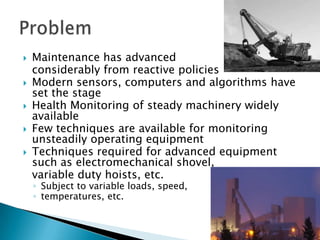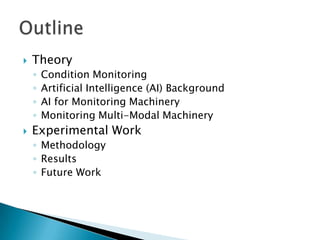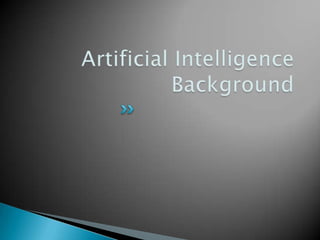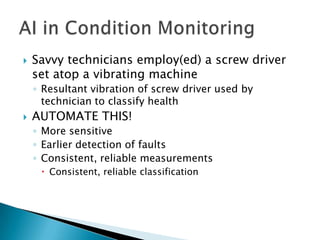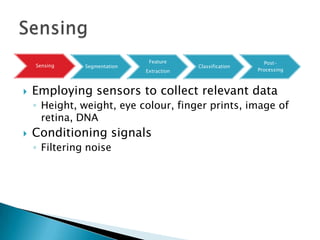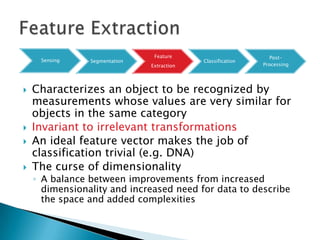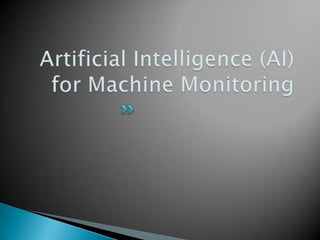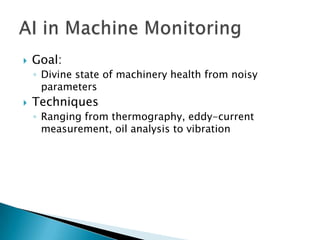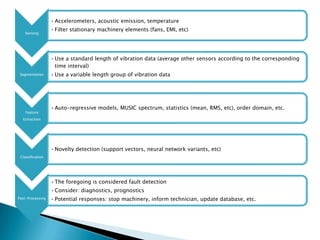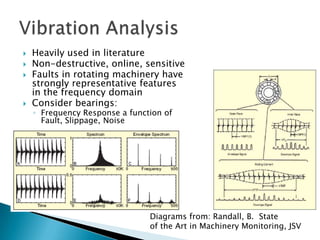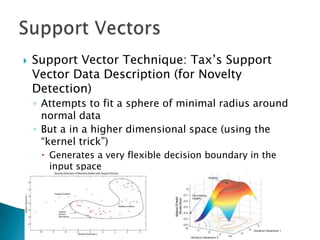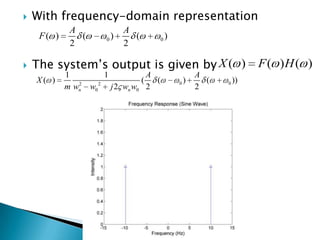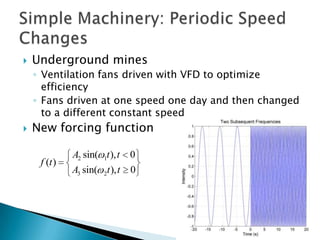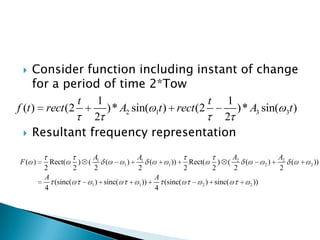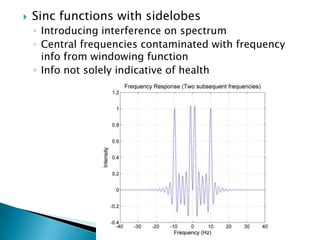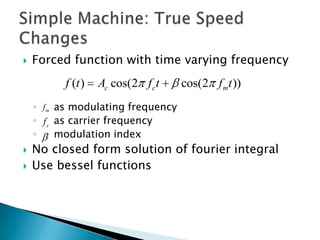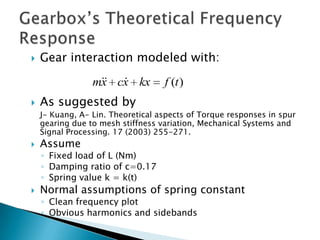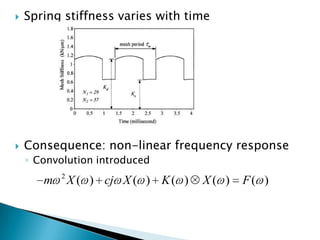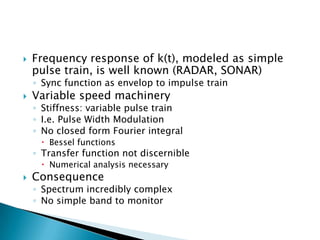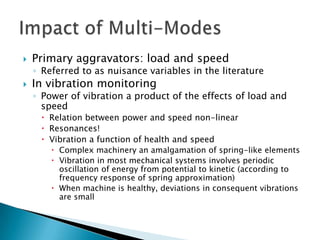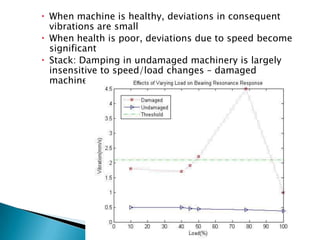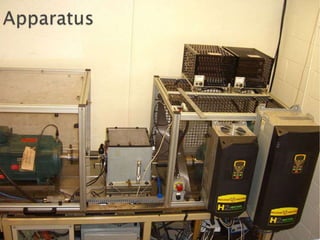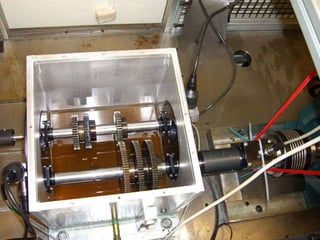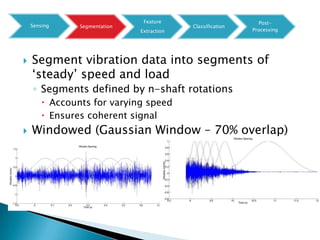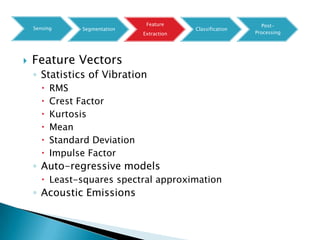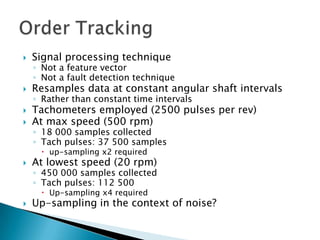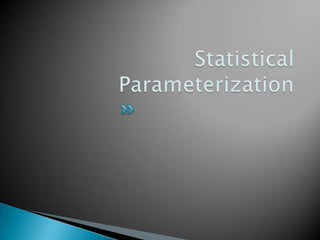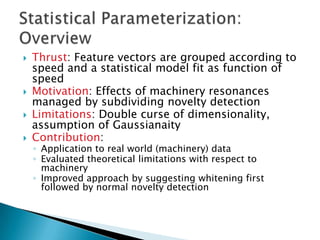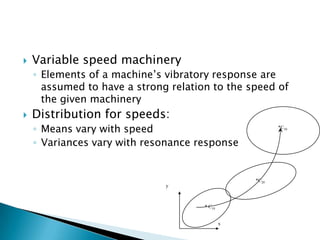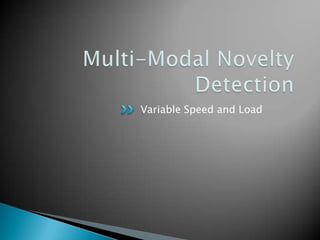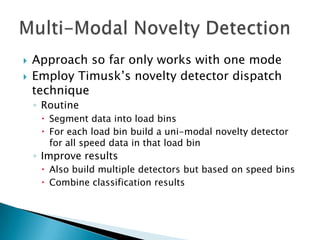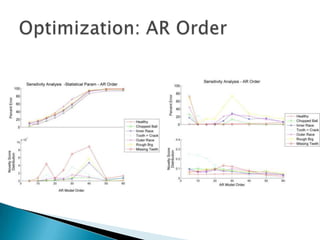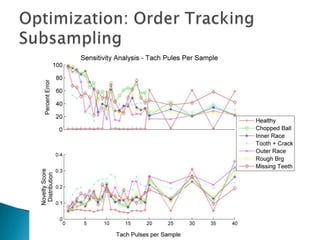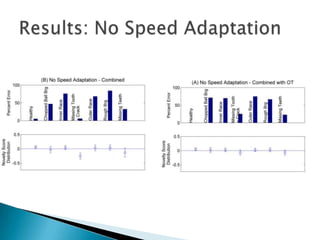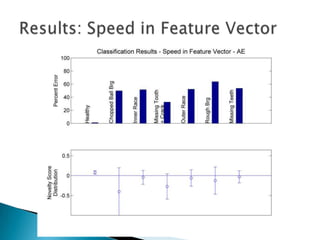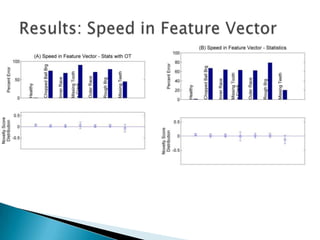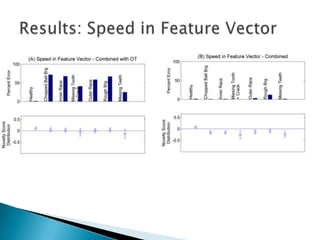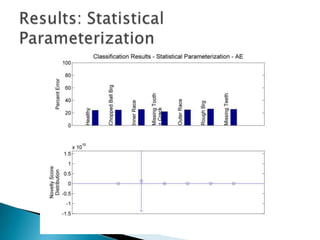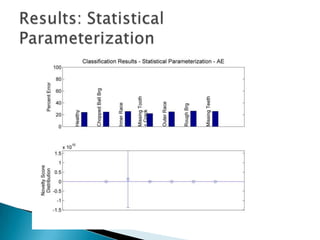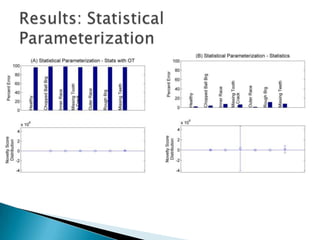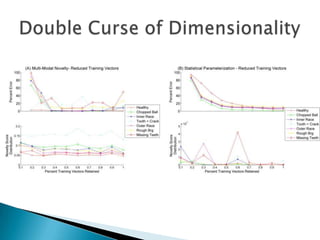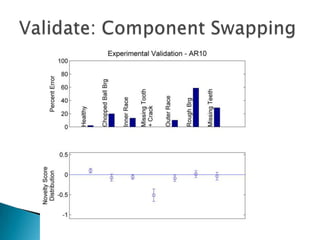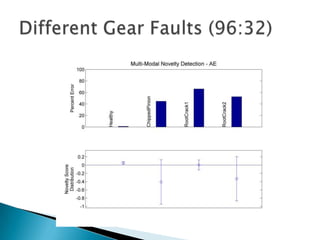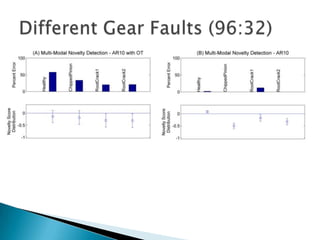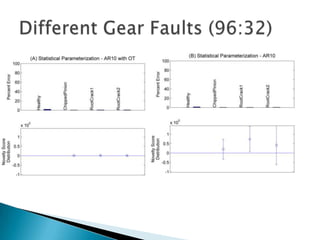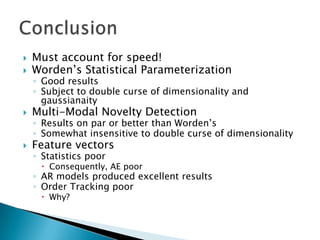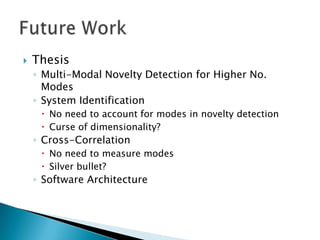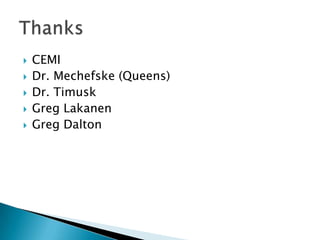CBM Variable Speed Machinery
- 1. As submitted to Mechanical Systems and Signal Processing Jordan McBain, P.Eng.
- 2. ´ü¢ Maintenance has advanced considerably from reactive policies ´ü¢ Modern sensors, computers and algorithms have set the stage ´ü¢ Health Monitoring of steady machinery widely available ´ü¢ Few techniques are available for monitoring unsteadily operating equipment ´ü¢ Techniques required for advanced equipment such as electromechanical shovel, variable duty hoists, etc. Ôùª Subject to variable loads, speed, Ôùª temperatures, etc.
- 3. ´ü¢ Theory Ôùª Condition Monitoring Ôùª Artificial Intelligence (AI) Background Ôùª AI for Monitoring Machinery Ôùª Monitoring Multi-Modal Machinery ´ü¢ Experimental Work Ôùª Methodology Ôùª Results Ôùª Future Work
- 5. ´ü¢ Machinery Maintenance Policy driven by: Ôùª Availability of resources (spare parts, pers., capital) Ôùª Importance of equipment Ôùª Availability of technology and expertise ´ü¢ Modern Maintenance Policy evolved through: Ôùª Run-to-Failure Ôùª Periodic Maintenance Ôùª Predictive Maintenance ´éû Maintenance is delayed until some monitored parameter of the equipment becomes erratic ´éû Proactive ´éû Balances resources
- 6. ´ü¢ Benefits: Ôùª Environment Ôùª Safety Ôùª Production Ôùª Staff Shortages/Costs Ôùª Scheduling Ôùª Spare Parts (JIT) Ôùª Insurance Ôùª Life Extension
- 8. ´ü¢ Savvy technicians employ(ed) a screw driver set atop a vibrating machine Ôùª Resultant vibration of screw driver used by technician to classify health ´ü¢ AUTOMATE THIS! Ôùª More sensitive Ôùª Earlier detection of faults Ôùª Consistent, reliable measurements ´éû Consistent, reliable classification
- 9. ´ü¢ One branch of artificial-intelligence domain ´ü¢ Usually involves representing a state or object to be indentified with a vector of commensurate numerical values ´ü¢ Representative vector called a ÔÇ£patternÔÇØ or ÔÇ£classification objectÔÇØ ´ü¢ Classification achieved by computing decision surfaces around classes of objects ´ü¢ Example: biometric classification of employees reporting to work
- 10. Feature Post- Sensing Segmentation Classification Extraction Processing Measurements Selecting Reducing Plotting -Decision Support (height, weight, measurement segmented values in -Also detect eye colour) interval measurements n-dimensions enebriation to key and fitting a -Pay numbers boundary -Etc.
- 11. Feature Post- Sensing Segmentation Classification Extraction Processing ´ü¢ Employing sensors to collect relevant data Ôùª Height, weight, eye colour, finger prints, image of retina, DNA ´ü¢ Conditioning signals Ôùª Filtering noise
- 12. Feature Post- Sensing Segmentation Classification Extraction Processing ´ü¢ Sensor data divided into useful chunks Ôùª Separate employees from one another ´éû Use a terminal for employees to sign in one at a time ´éû Use image processing and separate employees from each other in picture ´ü¢ One of the most difficult problems in pattern recognition
- 13. Feature Post- Sensing Segmentation Classification Extraction Processing ´ü¢ Characterizes an object to be recognized by measurements whose values are very similar for objects in the same category ´ü¢ Invariant to irrelevant transformations ´ü¢ An ideal feature vector makes the job of classification trivial (e.g. DNA) ´ü¢ The curse of dimensionality Ôùª A balance between improvements from increased dimensionality and increased need for data to describe the space and added complexities
- 14. Feature Post- Sensing Segmentation Classification Extraction Processing ´ü¢ Employs full feature vector provided by the feature extractor to assign the feature vectorÔǃs object to a category ´ü¢ Generalization ÔÇô learning from a training set extends well to unexperienced data ´ü¢ E.g. Neural Networks Ôùª As one would fit a model to an experimental data set with least-squares regression, in classification one would fit a boundary around a classÔǃ data set Ôùª Computationally equivalent tasks ´éû But in classification, the problem is non-linear
- 15. Feature Post- Sensing Segmentation Classification Extraction Processing ´ü¢ Perform some action subsequent to classification ´ü¢ Improve classification error based on context Ôùª Employ multiple classifiers
- 17. ´ü¢ Goal: Ôùª Divine state of machinery health from noisy parameters ´ü¢ Techniques Ôùª Ranging from thermography, eddy-current measurement, oil analysis to vibration
- 18. ÔÇó Accelerometers, acoustic emission, temperature ÔÇó Filter stationary machinery elements (fans, EMI, etc) Sensing ÔÇó Use a standard length of vibration data (average other sensors according to the corresponding time interval) Segmentation ÔÇó Use a variable length group of vibration data ÔÇó Auto-regressive models, MUSIC spectrum, statistics (mean, RMS, etc), order domain, etc. Feature Extraction ÔÇó Novelty detection (support vectors, neural network variants, etc) Classification ÔÇó The foregoing is considered fault detection ÔÇó Consider: diagnostics, prognostics Post-Processing ÔÇó Potential responses: stop machinery, inform technician, update database, etc.
- 19. ´ü¢ Heavily used in literature ´ü¢ Non-destructive, online, sensitive ´ü¢ Faults in rotating machinery have strongly representative features in the frequency domain ´ü¢ Consider bearings: Ôùª Frequency Response a function of Fault, Slippage, Noise Diagrams from: Randall, B. State of the Art in Machinery Monitoring, JSV
- 20. ´ü¢ Motivation: addresses imbalance of data from one class in relation to that of others Ôùª Data from faulted states are difficult to collect (economics, operation) ´ü¢ Sub problem of pattern recognition Ôùª train on the ÔÇ£normalÔÇØ class and then signal error when behaviour deviates from itDecision boundary encircles normal patterns ´ü¢ A wide variety of techniques available ´ü¢ Examine two: Ôùª Boundaries containing a certain quantile of data (i.e. a discordance test) Ôùª Boundaries derived by Support Vectors
- 21. ´ü¢ Support Vector Technique: TaxÔǃs Support Vector Data Description (for Novelty Detection) Ôùª Attempts to fit a sphere of minimal radius around normal data Ôùª But a in a higher dimensional space (using the ÔÇ£kernel trickÔÇØ) ´éû Generates a very flexible decision boundary in the input space
- 24. ´ü¢ Simplest machine Ôùª damped spring system ´Çª´Çª ´Çª mx cx kx f (t ) k c n m 2 km Ôùª Frequency domain representation 1 1 H ( w) 2 m wn w2 j 2 wn w Ôùª Forced with a function f (t ) A *sin( 0t )
- 25. ´ü¢ With frequency-domain representation A A F( ) ( 0) ( 0 ) 2 2 ´ü¢ The systemÔǃs output is given by X ( ) F ( )H ( ) 1 1 A A X( ) 2 2 ( ( 0) ( 0 )) m wn w0 j 2 wn w0 2 2
- 26. ´ü¢ Underground mines Ôùª Ventilation fans driven with VFD to optimize efficiency Ôùª Fans driven at one speed one day and then changed to a different constant speed ´ü¢ New forcing function A2 sin( 1t ), t 0 f (t ) A3 sin( 2t ), t 0
- 27. ´ü¢ Examine function for one day (windowing) t f (t ) rect ( )* A4 sin( 3t ) ´ü¢ Frequency representation (convolution operator): A A F( ) Rect( ) ( ( 3) ( 3 )) 2 2 A A sinc( ) ( ( 3 ) ( 3 )) 2 2 A (sinc( 3 ) sinc( 3 )) 2 ´ü¢ SystemÔǃs response to forcing, similar Ôùª Spectral leakage and smearing by windowing
- 28. ´ü¢ Consider function including instant of change for a period of time 2*Tow t 1 t 1 f (t ) rect (2 )* A2 sin( 1t ) rect (2 )* A3 sin( 3t ) 2 2 ´ü¢ Resultant frequency representation A1 A1 A2 A2 F( ) Rect( ) ( ( 1) ( 1 )) Rect( ) ( ( 2) ( 2 )) 2 2 2 2 2 2 2 2 A A (sinc( 1) sinc( 1 )) (sinc( 2 ) sinc( 2 )) 4 4
- 29. ´ü¢ Sinc functions with sidelobes Ôùª Introducing interference on spectrum Ôùª Central frequencies contaminated with frequency info from windowing function Ôùª Info not solely indicative of health
- 30. ´ü¢ Forced function with time varying frequency f (t ) Ac cos(2 f ct cos(2 f mt )) Ôùª f m as modulating frequency Ôùª f c as carrier frequency Ôùª modulation index ´ü¢ No closed form solution of fourier integral ´ü¢ Use bessel functions
- 31. ´ü¢ (Mathematically) unlimited bandwidth ´ü¢ In practice 98% of bandwidth determined by beta
- 32. ´ü¢ Examining over a period of time (windowing) Ôùª Introduces sinc functions mounted on impulses Ôùª Consequence: spectral interference ´ü¢ Conclusion Ôùª Frequency domain contains valuable info on: ´éû System behaviour ´éû Faults manifested in the form of changes in stiffness and damping ´éû Forcing function Ôùª Info in frequency bands not limited to system behaviour
- 33. ´ü¢ Gear interaction modeled with: ´Çª´Çª ´Çª mx cx kx f (t ) ´ü¢ As suggested by J- Kuang, A- Lin. Theoretical aspects of Torque responses in spur gearing due to mesh stiffness variation, Mechanical Systems and Signal Processing. 17 (2003) 255-271. ´ü¢ Assume Ôùª Fixed load of L (Nm) Ôùª Damping ratio of c=0.17 Ôùª Spring value k = k(t) ´ü¢ Normal assumptions of spring constant Ôùª Clean frequency plot Ôùª Obvious harmonics and sidebands
- 34. ´ü¢ Spring stiffness varies with time ´ü¢ Consequence: non-linear frequency response Ôùª Convolution introduced 2 m X ( ) cj X ( ) K ( ) X( ) F( )
- 35. ´ü¢ Frequency response of k(t), modeled as simple pulse train, is well known (RADAR, SONAR) Ôùª Sync function as envelop to impulse train ´ü¢ Variable speed machinery Ôùª Stiffness: variable pulse train Ôùª I.e. Pulse Width Modulation Ôùª No closed form Fourier integral ´éû Bessel functions Ôùª Transfer function not discernible ´éû Numerical analysis necessary ´ü¢ Consequence Ôùª Spectrum incredibly complex Ôùª No simple band to monitor
- 36. ´ü¢ Primary aggravators: load and speed Ôùª Referred to as nuisance variables in the literature ´ü¢ In vibration monitoring Ôùª Power of vibration a product of the effects of load and speed ´éû Relation between power and speed non-linear ´éû Resonances! ´éû Vibration a function of health and speed ´éû Complex machinery an amalgamation of spring-like elements ´éû Vibration in most mechanical systems involves periodic oscillation of energy from potential to kinetic (according to frequency response of spring approximation) ´éû When machine is healthy, deviations in consequent vibrations are small
- 37. ´éû When machine is healthy, deviations in consequent vibrations are small ´éû When health is poor, deviations due to speed become significant ´éû Stack: Damping in undamaged machinery is largely insensitive to speed/load changes ÔÇô damaged machinery is not
- 41. Feature Post- Sensing Segmentation Classification Extraction Processing ´ü¢ Segment vibration data into segments of ÔÇ×steadyÔǃ speed and load Ôùª Segments defined by n-shaft rotations ´éû Accounts for varying speed ´éû Ensures coherent signal ´ü¢ Windowed (Gaussian Window ÔÇô 70% overlap)
- 42. ´ü¢ Steady speed/load not guaranteed Ôùª But can generate segments with reasonable steadiness and variance can be computed ´ü¢ Group vibration segments into bins of a selected size Ôùª Size effects how many classification objects in each bin ´éû curse of dimensionality balanced against need for very fine modal resolution
- 43. Feature Post- Sensing Segmentation Classification Extraction Processing ´ü¢ Feature Vectors Ôùª Statistics of Vibration ´éû RMS ´éû Crest Factor ´éû Kurtosis ´éû Mean ´éû Standard Deviation ´éû Impulse Factor Ôùª Auto-regressive models ´éû Least-squares spectral approximation Ôùª Acoustic Emissions
- 44. ´ü¢ Signal processing technique Ôùª Not a feature vector Ôùª Not a fault detection technique ´ü¢ Resamples data at constant angular shaft intervals Ôùª Rather than constant time intervals ´ü¢ Tachometers employed (2500 pulses per rev) ´ü¢ At max speed (500 rpm) Ôùª 18 000 samples collected Ôùª Tach pulses: 37 500 samples ´éû up-sampling x2 required ´ü¢ At lowest speed (20 rpm) Ôùª 450 000 samples collected Ôùª Tach pulses: 112 500 ´éû Up-sampling x4 required ´ü¢ Up-sampling in the context of noise?
- 45. Feature Post- Sensing Segmentation Classification Extraction Processing
- 47. ´ü¢ Thrust: Feature vectors are grouped according to speed and a statistical model fit as function of speed ´ü¢ Motivation: Effects of machinery resonances managed by subdividing novelty detection ´ü¢ Limitations: Double curse of dimensionality, assumption of Gaussianaity ´ü¢ Contribution: Ôùª Application to real world (machinery) data Ôùª Evaluated theoretical limitations with respect to machinery Ôùª Improved approach by suggesting whitening first followed by normal novelty detection
- 48. ´ü¢ Variable speed machinery Ôùª Elements of a machineÔǃs vibratory response are assumed to have a strong relation to the speed of the given machinery ´ü¢ Distribution for speeds: Ôùª Means vary with speed *C30 Ôùª Variances vary with resonance response *C20 y * C10 x
- 49. Variable Speed and Load
- 50. ´ü¢ Thrust: One mode is included in the feature vector which are grouped into bins according to ranges of other mode (then employ multi-novelty detector dispatch) ´ü¢ Motivation: Advance the technique to higher modes ´ü¢ Limitations: Curse of dimensionality, large number of modes impractical, brute force ´ü¢ Contribution: Ôùª Very practical technique compared to literature (for load and speed) Ôùª ÔÇ£CrossingÔÇØ modes to enhance classification results ´ü¢ Experimental Data: LaurentianÔǃs TVS ´ü¢ Status: Not yet validated
- 51. ´ü¢ Approach so far only works with one mode ´ü¢ Employ TimuskÔǃs novelty detector dispatch technique Ôùª Routine ´éû Segment data into load bins ´éû For each load bin build a uni-modal novelty detector for all speed data in that load bin Ôùª Improve results ´éû Also build multiple detectors but based on speed bins ´éû Combine classification results
- 52. ´ü¢ Averaging modes still a problem Ôùª Employ previous improvements ´ü¢ Curse of dimensionality increases Ôùª Some mitigation possible ´ü¢ Brute force Ôùª Across of the spectrum of techniques, not as bad as parzen windowing (enter dataset is memorized) ´ü¢ Higher number of modes increases computational complexities and curse of dimensionality
- 75. ´ü¢ Must account for speed! ´ü¢ WordenÔǃs Statistical Parameterization Ôùª Good results Ôùª Subject to double curse of dimensionality and gaussianaity ´ü¢ Multi-Modal Novelty Detection Ôùª Results on par or better than WordenÔǃs Ôùª Somewhat insensitive to double curse of dimensionality ´ü¢ Feature vectors Ôùª Statistics poor ´éû Consequently, AE poor Ôùª AR models produced excellent results Ôùª Order Tracking poor ´éû Why?
- 76. ´ü¢ Thesis Ôùª Multi-Modal Novelty Detection for Higher No. Modes Ôùª System Identification ´éû No need to account for modes in novelty detection ´éû Curse of dimensionality? Ôùª Cross-Correlation ´éû No need to measure modes ´éû Silver bullet? Ôùª Software Architecture
- 77. ´ü¢ CEMI ´ü¢ Dr. Mechefske (Queens) ´ü¢ Dr. Timusk ´ü¢ Greg Lakanen ´ü¢ Greg Dalton


